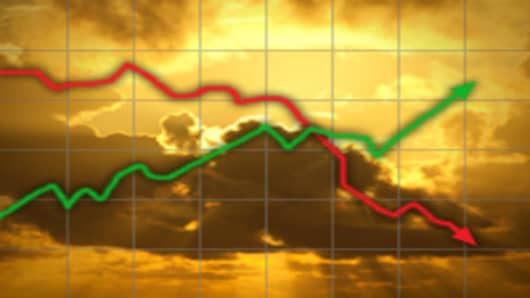Here's another bright sign for the stock markets: both the Nasdaq and the S&P 500 hit a golden cross this week for the first time in four years.
A golden cross is when the 50-day moving average for an index crosses above the 200-day moving average.
The pattern occurs when prices over the shorter term are moving higher at a faster rate than prices over the longer-term. TheDow Jones Industrial Averagehit the golden cross Oct. 1.
It's also a bullish sign for the future, say strategists who watch the charts.
"Historically, the market has performed better following these patterns than if you were look at any random one, three or six-month period," said Paul Hickey, co-founder of Bespoke Investment Group.
Specifically, the average six-month return of the S&P 500 Indexfollowing a golden cross was 3.9 percent from 1929 through 2010, while the S&P 500's average six-month return any other time was 3.1 percent, according to Bespoke's research. The research also shows the six-month average return following the golden cross is positive 63 percent of the time.
"If you look at the S&P 500 data since 1972, the S&P 500 outperformed its average for the year as well, rising 11.9 percent on average in the year after a golden cross, versus 7.9 percent on average, according to Schaeffer's Investment Research."
For the Nasdaq, the six-month results have been positive 83 percent of time following the golden cross since the index began in 1971, with the Nasdaq averaging 8.7 percent in the six months after a golden cross, versus the typical average gain of 4.2 percent, Bespoke found.
If you look at the S&P 500 data since 1972, the S&P 500 outperformed its average for the year as well, rising 11.9 percent on average in the year after a golden cross, versus 7.9 percent on average, according to Schaeffer's Investment Research.
The inverse of the golden cross is the death cross, which got a lot of attention back in Julyas a bearish signal for the market. Since then, the S&P 500 has risen more than 15 percent. According to Todd Salamone, senior vice president of research at Schaeffer, it's not unusual for the market to go up following a death cross.
After a death cross, the S&P 500 "does underperform its historical average, but it doesn’t necessarily go down," Salamone said.
______________________________
CNBC Data Pages:
- Dow 30 Stocks—In Real Time
- Oil, Gold, Natural Gas Prices Now
- Where's the US Dollar Today?
- Track Treasury Prices Here
______________________________
CNBC Slideshows:


